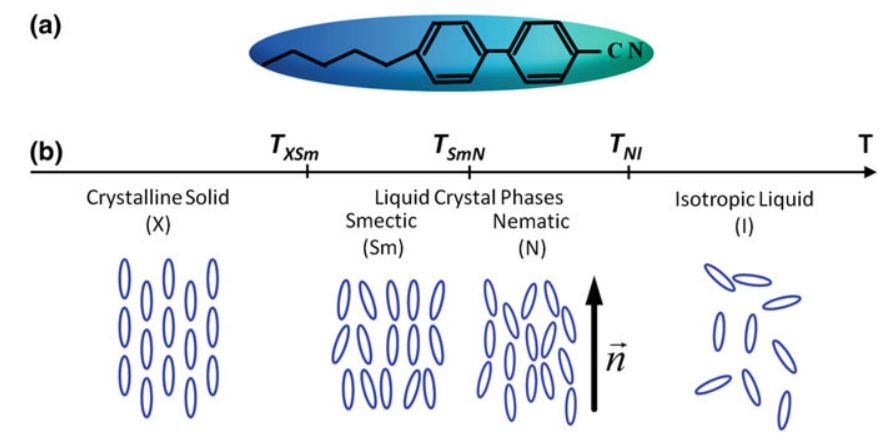Liquid Crystals Materials
Liquid crystal is an intermediate phase between crystal and liquid. In 1888, the Austrian botanist F. Reinitzer observed that cholesterol first turned into a cloudy liquid during heating, and then turned into a transparent liquid when heated. German physicist O. Lehmann jointly studied this phenomenon and found that this material has optical properties similar to crystals under a polarized light microscope. Because this substance has both liquid and crystalline properties, it is named "liquid crystal". Liquid crystal not only has the easy flowability of liquid, but also has the characteristics of crystal anisotropy. It is a kind of polymer material. The intermolecular force is weaker than that of solids, and it is easy to show various states. Small external energy such as electric field, magnetic field, thermal energy, etc. can realize the transition between various molecular states, thus causing its changes in physical properties.
 Fig. 1 The change process of matter from low temperature to high temperature [1]
Fig. 1 The change process of matter from low temperature to high temperature [1]
Classifications of Liquid Crystals
Liquid crystals can be divided into smectic type and nematic type, cholesteric type and disc type according to their molecular arrangement.
- Smectic type
Rod-like molecules are arranged parallel to each other into a layered structure, and the long axis is perpendicular to the layer plane. The layers can slide relative to each other, and the flow in the direction perpendicular to the layers is difficult. This is a type of liquid crystal that is closest to the crystalline structure, which viscosity is high.
- Nematic type
The rod-shaped molecules are arranged in parallel with each other, but their center of gravity is disordered, and only one-dimensional order is preserved. Molecules are easily oriented and cross each other along the flow direction. Therefore, the nematic liquid crystal has greater fluidity.
The flat long molecules are arranged in parallel with each other in a layered structure by the interaction of the end groups, and the long axis is in the plane. Due to the interaction of the optically active groups extending out of the plane, the long-axis orientations of the adjacent interlayer molecules are regularly twisted by a certain angle in turn to form a helical plane structure. Such liquid crystals have extremely high optical rotation properties.
- Disc type
It is a disc-shaped crystal material or columnar system with high symmetry original molecular overlapping composition.
Applications
- LCD screen
In life, the most common application of liquid crystal materials is liquid crystal displays When the liquid crystal driven by the electric field between the two electrodes, the electric field driving between the two electrodes can cause the electric field effect of the twisting of the liquid crystal molecules to control the transmission or shielding of the light source
- Dimming glass
The most common dimming glass using polymer dispersed liquid crystal is PDLC (Polymer Dispersed Liquid Crystal). Polymer-dispersed liquid crystal is a liquid crystal dispersed in an organic solid polymer matrix with micron-sized droplets. Dimming glass can be freely controlled to switch between transparent and opaque states by charging or not.
- Liquid crystal grating
As a kind of grating, liquid crystal grating has the characteristics of interference and diffraction in theory, and can replace the traditional grating to achieve the effects of dispersion, beam splitting, polarization and so on. Due to its modulation, it can often play a special role in certain scenarios. Taking naked-eye 3D as an example, 2D/3D switching can be achieved by controlling the power-on using a liquid crystal grating.
Liquid crystal materials are being widely used in the field of display technology and remain the mainstream display. In addition, liquid crystals also have broad application prospects in non-display fields because of their excellent modulated optoelectronic properties. As an excellent optoelectronic material, liquid crystal material will play an increasingly important role in national life and technological development.
Reference
- Hamley, Ian W. Introduction to soft matter: synthetic and biological self-assembling materials. John Wiley & Sons, 2013.
![{[Name]}](/upload/cover/Liquid-Crystals-Materials-cover-1.jpg)
![{[Name]}](/upload/cover/Liquid-Crystals-Materials-cover-2.jpg)
![{[Name]}](/upload/cover/Liquid-Crystals-Materials-cover-3.jpg)
